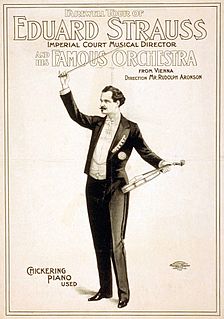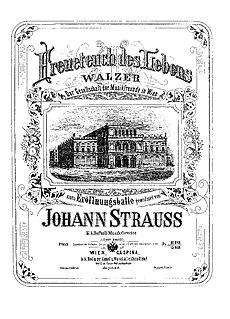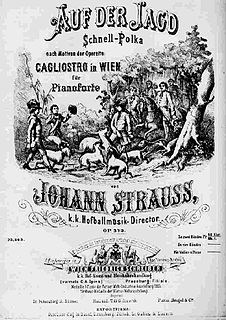Related Research Articles

Johann Strauss II, also known as Johann Strauss Jr., the Younger, the Son, was an Austrian composer of light music, particularly dance music and operettas. He composed over 500 waltzes, polkas, quadrilles, and other types of dance music, as well as several operettas and a ballet. In his lifetime, he was known as "The Waltz King", and was largely responsible for the popularity of the waltz in Vienna during the 19th century. Some of Johann Strauss's most famous works include "The Blue Danube", "Kaiser-Walzer", "Tales from the Vienna Woods", and the "Tritsch-Tratsch-Polka". Among his operettas, Die Fledermaus and Der Zigeunerbaron are the best known.

Johann Strauss I was an Austrian Romantic composer. He was famous for his waltzes, and he popularized them alongside Joseph Lanner, thereby setting the foundations for his sons to carry on his musical dynasty. He is best known for his composition of the Radetzky March.

Josef Strauss was an Austrian composer.

Eduard "Edi" Strauss was an Austrian composer who, together with his brothers Johann Strauss II and Josef Strauss made up the Strauss musical dynasty. He was the son of Johann Strauss I and Maria Anna Streim. The family dominated the Viennese light music world for decades, creating many waltzes and polkas for many Austrian nobility as well as dance-music enthusiasts around Europe. He was affectionately known in his family as 'Edi'.

Rathausball-Tänze op. 438 is a waltz by composer Johann Strauss II written in 1890 in honour of the inauguration of the new city hall of Vienna. At the opening of the new banqueting hall (Festsaal) on 12 February 1890 two rival orchestras were commissioned to provide dance music for the occasion; the Strauss Orchestra under the direction of Eduard Strauss, and that of rival Kapellmeister Karl Michael Ziehrer who was head of the Vienna House Regiment 'Hoch und Deutschmeister No. 4'.
Gross-Wien Op. 440 is a waltz by Johann Strauss II written in 1891 and was a choral waltz for the Wiener Männergesang-Verein during the Vienna Fasching (Carnival) of the same year. The text for the choral version of the waltz was by Franz von Gernerth.

Tritsch-Tratsch-Polka, Op. 214, is a polka in A major by Johann Strauss II, written in 1858 after a successful tour of Russia where he performed in the summer concert season at Pavlovsk, Saint Petersburg. It was first performed in a concert in Vienna on 24 November 1858.
Künstlerleben, Op. 316 is a waltz written by Johann Strauss II in 1867, following closely on the success of the popular "The Blue Danube". Austria was severely shaken the previous year 1866 by the crushing defeat that the Austrian army suffered in the Battle of Königgrätz and many of the year's festivities and balls were cancelled as the prevalent depressing mood affected most of Vienna's populace.
Im Krapfenwald'l op. 336 is a polka by Johann Strauss II written in 1869 and was originally titled 'Im Pawlowsk Walde' when first performed in Pavlovsk on 6 September 1869. Reportedly, several encores of the piece was called for and Strauss felt moved to retitled the piece to suit his audience back in native Vienna.
Neu Wien , opus 342, is a waltz written by Johann Strauss II in 1870 and dedicated to Nicolaus Dumba (1830-1900), who was a fervent patron of Arts and was the Chairman of the Wiener Männergesang-Verein and Vice-President of the Gesellschaft der Musikfreunde in Wien.

Waltzes from Vienna is a 1934 British biographical film directed by Alfred Hitchcock, sometimes known as Strauss' Great Waltz. It was part of the cycle of operetta films made in Britain during the 1930s.

Indigo und die vierzig Räuber is an operetta composed by Johann Strauss II to a German libretto by Maximilian Steiner based on the tale "Ali Baba and the Forty Thieves" from The Book of One Thousand and One Nights.
Vienna Waltzes is a ballet made by New York City Ballet co-founder and founding choreographer George Balanchine to music by Johann Strauss, Jr., Franz Lehár, and Richard Strauss:

Freuet Euch des Lebens, op. 340, is a Viennese Waltz composed by Johann Strauss II. It was written for the Vienna Gesellschaft der Musikfreunde, and premiered at the new Musikverein building in Vienna in 1870.
Lob der Frauen, Op. 315, is a polka-mazurka composed by Johann Strauss II. The composition was first performed at the Vienna Volksgarten at the 1867 Carnival in Vienna. The work was performed alongside other compositions that Strauss had written around that period, including the famous waltzes Blue Danube and Artist's Life.

"Auf der Jagd", op. 373, is a polka composed by Johann Strauss II. The composition is based on melodies in Strauss' operetta Cagliostro in Wien.
Persischer Marsch, Op. 289, is a march in G minor composed by Johann Strauss II in the autumn of 1864. The composer conducted the first Viennese performance of the march in December 1864 at a festival concert in the Vienna Volksgarten to celebrate the 20th anniversary of his debut as a composer. When Naser al-Din Shah Qajar, to whom Strauss had dedicated the march, visited Vienna for the 1873 Vienna World's Fair, a military band, unable to acquire the music for the authentic Persian anthem, instead played this march as a hymn for the Shah.
Rhadamantus-Klänge, Op. 94, is a waltz composed by Johann Strauss II. It was written for the 1851 Vienna Carnival. The title of the work was named after Rhadamanthus, one of the judges of the underworld in Greek mythology. Eduard Strauss, the composer's youngest brother, included the waltz's opening number in his potpourri Bluthenkranz Johann Strauss'scher Walzer, opus 292.
Novellen, opus 146, is a waltz composed by Johann Strauss II. The composition was dedicated to the law students of the Vienna University on the occasion of their ball held at the Sofienbad-Saal in Vienna on January 31, 1854. The work reflects Strauss's fascination for the 'revolutionary' orchestrations of Wagner and Meyerbeer. Due to this, the music critic Eduard Hanslick was highly critical of the waltz, saying that "with their lengthy eight-bar motifs, their groaning diminished seventh and ninth chords, [and] the thundering noise of their trombones and timpani, [they] are no longer appropriate for dancing.

Eduard Leopold Maria Strauss, commonly known as Eduard Strauss II to distinguish him from his grandfather, was an Austrian conductor whose grandfather was Eduard Strauss I and whose uncle was Johann Strauss III.
References
- ↑ "STRAUSS II, J,: Edition - Vol. 1 CD". NaxosDirect. Archived from the original on 2011-07-14. Retrieved 2008-10-09.
| | This article about a classical composition is a stub. You can help Wikipedia by expanding it. |